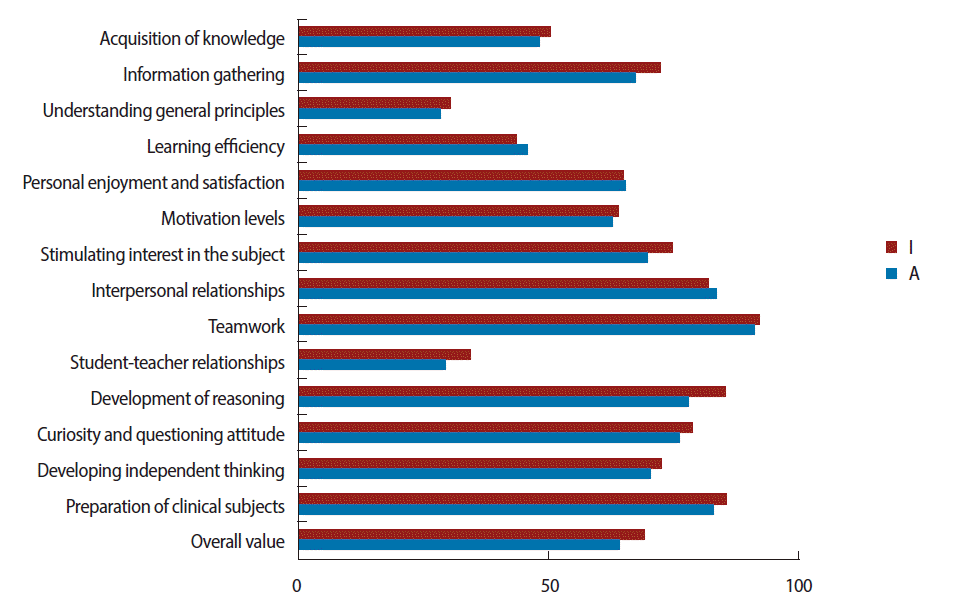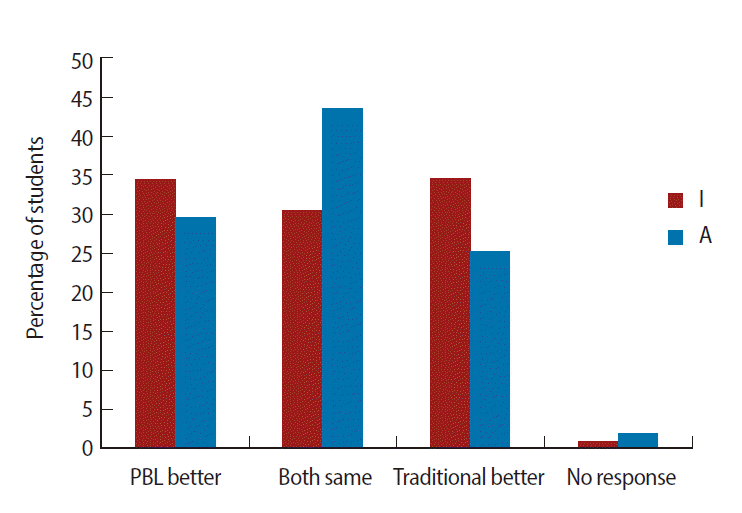Out of the 800 students recruited for the study, 773 returned a completed questionnaire. Of these, 159 students were from category “A”, whereas 614 students were from “I”. For most of the items, the students rated PBL to be better than the traditional method. PBL scored highest for instilling the capacity for teamwork, preparing students to face clinical postings, development of reasoning, independent thinking, curiosity, and a questioning attitude, and finally, for generating good interpersonal relationships amongst students. Irrespective of their schooling, the majority of the students believed that the overall value of PBL was greater than that of the traditional method of teaching (
Fig. 1).
Table 1 shows the results of data pooled from both the ‘I’ and the ‘A’ groups (scoring pattern 0, 1, 2). There was a highly significant difference between the mean scores for PBL and traditional methods for most of the items of the questionnaire except for “learning efficiency”, “understanding principles”, and “student-teacher relationships”. Though not significant, scores for learning efficiency were higher for PBL. As far as understanding of principles was concerned, the majority of the students were of the opinion that the traditional method was better (44.02% of the “I” group and 46.09% of the “A” group), while the rest were more or less equally divided between “both the same” and “PBL better”, corresponding with the mean score in favor of the traditional method (
Fig. 2). Moreover, even with detailed analysis of the pooled data, the mean scores for the traditional method were higher (
Table 1), suggesting a tendency for a slight preference towards the traditional method (P=0.051). In case of student-teacher relationships, the majority of students from the “A” group believed that it was similar for both the modes of teaching, though amongst students of the “I” group, approximately a third believed PBL was better, another third felt that both had equal value, and the remaining third opined that the traditional mode was better (
Fig. 3). Pooled data analysis found marginally higher mean scores for the traditional method, but these were not statistically significant.
 | Fig. 1Percentage of students favoring problem-based learning with respect to various items in Kasturba Medical College Manipal, Manipal University, India. I: at least 10 years of schooling in India before entering medical school; A: at least 10 years of schooling abroad before entering medical school. PBL, problem-based learning. 
|
 | Fig. 2Preference of students with respect to understanding principles on problem-based learning experiences in the undergraduate curriculum in Kasturba Medical College Manipal, Manipal University, India. I: at least 10 years of schooling in India before entering medical school; A: at least 10 years of schooling abroad before entering medical school. PBL, problem-based learning. 
|
 | Fig. 3Preference of students with respect to student-teacher relationships on problem-based learning experiences in the undergraduate curriculum in Kasturba Medical College Manipal, Manipal University, India. I: at least 10 years of schooling in India before entering medical school; A: at least 10 years of schooling abroad before entering medical school. PBL, problem-based learning. 
|
Table 1.
Mean scores of all students’ preference to 15 items, based on a 0, 1, 2 scoring system on problem-based learning experiences in the undergraduate curriculum in Kasturba Medical College Manipal, Manipal University, India.
|
Traditional better |
PBL better |
P-value |
|
Number of students |
Mean score |
Number of students |
Mean score |
|
Acquisition of knowledge |
80 |
0.84 |
110 |
0.93 |
NS |
|
Information gathering |
49 |
0.61 |
135 |
1.19 |
<0.0001 |
|
Understanding general principles |
112 |
0.98 |
87 |
0.57 |
NS |
|
Learning efficiency |
85 |
0.87 |
106 |
0.91 |
NS |
|
Personal enjoyment and satisfaction |
55 |
0.67 |
138 |
1.12 |
<0.001 |
|
Motivation level |
58 |
0.48 |
139 |
1.02 |
<0.001 |
|
Stimulating interest in the subject |
49 |
0.73 |
137 |
1.16 |
0.002 |
|
Interpersonal relationships |
24 |
0.21 |
154 |
1.34 |
<0.001 |
|
Teamwork |
14 |
0.14 |
158 |
1.49 |
<0.001 |
|
Student-teacher relationship |
109 |
0.54 |
116 |
0.54 |
NS |
|
Development of reasoning |
34 |
0.50 |
146 |
1.34 |
<0.001 |
|
Curiosity and a questioning attitude |
34 |
0.38 |
145 |
1.20 |
<0.001 |
|
Developing independent thinking |
47 |
0.40 |
144 |
0.78 |
<0.001 |
|
Preparation for clinical subjects |
25 |
0.32 |
151 |
1.39 |
< 0.001 |
|
Overall value |
56 |
0.79 |
127 |
0.99 |
0.006 |








 PDF
PDF Citation
Citation Print
Print




 XML Download
XML Download